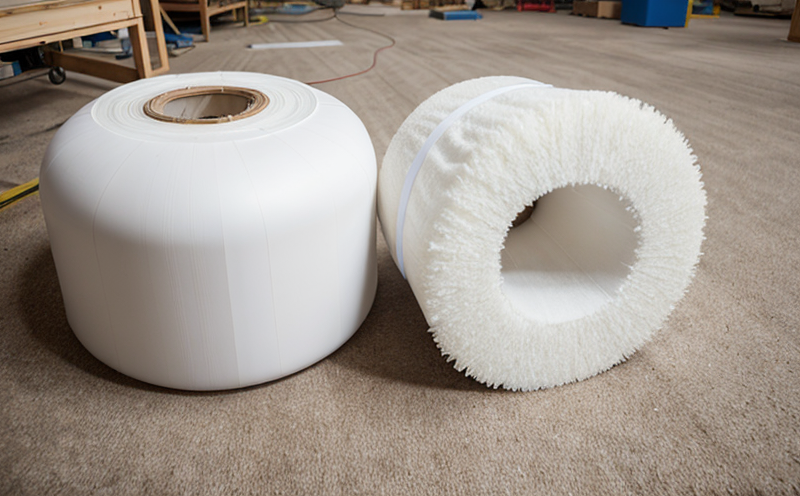ASTM E2235 Reverberation Room Acoustic Absorption Testing
The ASTM E2235 standard is widely recognized as a cornerstone method for evaluating the acoustic absorption properties of materials and insulation systems. This testing protocol is crucial in sectors where sound control, noise reduction, and environmental comfort are paramount.
Reverberation room tests determine how effectively a material or system absorbs sound energy. This metric is essential for applications ranging from automotive interiors to building acoustics, HVAC systems, and industrial machinery enclosures. The test involves placing the sample in a controlled environment where sound waves are absorbed by the specimen, and the remaining reflections are measured.
The testing procedure follows strict procedures outlined in ASTM E2235, ensuring consistency across laboratories worldwide. The reverberation room is designed to maintain a uniform sound field within a specified tolerance level. Samples are subjected to controlled sound fields of known intensity, typically ranging from 100 Hz to 8000 Hz, depending on the application.
Testing specimens can include various materials such as acoustic foams, mineral wool, glass fiber insulation, and composite panels used in both residential and commercial settings. The results provide valuable insights into how effectively these materials can suppress sound, contributing significantly to noise management strategies.
The ASTM E2235 test is not only critical for manufacturers aiming to meet stringent acoustic performance requirements but also for regulatory compliance. Many industries are subject to international standards that mandate specific levels of noise reduction and comfort in enclosed spaces. For instance, automotive manufacturers must ensure that interiors meet certain sound absorption criteria to enhance passenger experience.
The test results from ASTM E2235 can significantly influence product design decisions. By understanding the acoustic properties of materials early in the development process, engineers can optimize designs for better noise control and energy efficiency. This testing is particularly important for products that are exposed to high-frequency sound waves or operate in noisy environments.
The reverberation room test is versatile and applicable across a wide range of industries, including automotive, aerospace, building construction, HVAC, and electronics. In each sector, the importance of acoustic absorption varies, but the ASTM E2235 standard remains a universal benchmark for evaluating performance.
- Automotive: Interior materials must absorb sound to reduce noise levels in vehicles.
- Aerospace: Insulation systems help minimize noise within aircraft cabins and engines.
- Building Construction: Wall and ceiling panels contribute to overall building acoustics.
- HVAC Systems: Efficient sound absorption helps in reducing background noise in air conditioning units.
Benefits
The ASTM E2235 Reverberation Room Acoustic Absorption Testing offers numerous benefits to manufacturers, compliance officers, and R&D engineers:
- Enhanced Compliance: Ensures that products meet international standards for noise reduction.
- Improved Product Quality: Provides detailed insights into material performance, aiding in quality control.
- Innovation: Helps in the development of new materials and designs with superior acoustic properties.
- Cost-Effective: Prevents costly rework by identifying issues early in the design phase.
- Market Differentiation: Demonstrates a commitment to high-quality products, enhancing brand reputation.
Why Choose This Test
Selecting ASTM E2235 Reverberation Room Acoustic Absorption Testing is advantageous due to its comprehensive and standardized approach:
The test ensures that all materials undergo consistent evaluation, providing reliable data for decision-making. The controlled environment of the reverberation room minimizes external variables, ensuring accurate results.
By leveraging ASTM E2235, businesses can confidently meet regulatory requirements and industry standards. This testing method is internationally recognized and accepted by major markets, making it easier to comply with global norms.
The detailed reports generated from this test provide actionable insights that can be used to refine product designs and improve performance. Compliance officers appreciate the thoroughness of ASTM E2235, as it offers clear evidence of adherence to relevant standards.
International Acceptance and Recognition
- United States: ASTM E2235 is widely used in the construction industry for building materials.
- Europe: The standard is recognized by the European Committee for Standardization (CEN).
- Australia: Compliance with ASTM standards ensures market access and regulatory acceptance.
- New Zealand: ASTM E2235 is a key reference in noise control applications.





